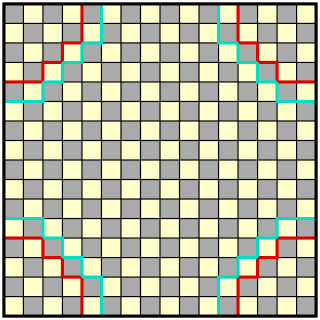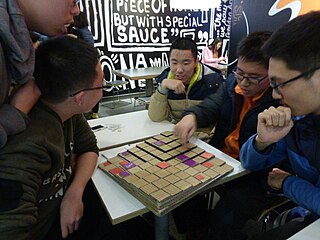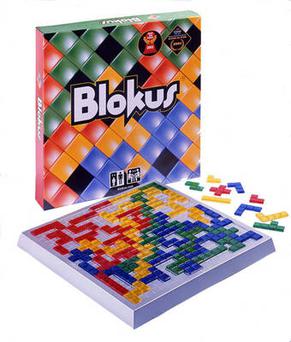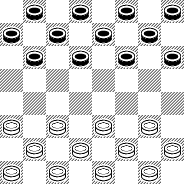
The L game is a simple abstract strategy board game invented by Edward de Bono. It was introduced in his book The Five-Day Course in Thinking (1967).

The L game is a simple abstract strategy board game invented by Edward de Bono. It was introduced in his book The Five-Day Course in Thinking (1967).
The L game is a two-player game played on a board of 4×4 squares. Each player has a 3×2 L-shaped tetromino, and there are two 1×1 neutral pieces.
On each turn, a player must first move their L piece, and then may optionally move either one of the neutral pieces. The game is won by leaving the opponent unable to move their L piece to a new position.
Pieces may not overlap or cover other pieces, or let the pieces off the board. On moving the L piece, it is picked up and then placed in empty squares anywhere on the board. It may be rotated or even flipped over in doing so; the only rule is that it must end in a different position from the position it started—thus covering at least one square it did not previously cover. To move a neutral piece, a player simply picks it up then places it in an empty square anywhere on the board.
One basic strategy is to use a neutral piece and one's own piece to block a 3×3 square in one corner, and use a neutral piece to prevent the opponent's L piece from swapping to a mirror-image position. Another basic strategy is to move an L piece to block a half of the board, and use the neutral pieces to prevent the opponent's possible alternate positions.
These positions can often be achieved once a neutral piece is left in one of the eight killer spaces on the perimeter of the board. The killer spaces are the spaces on the perimeter, but not in a corner. On the next move, one either makes the previously placed killer a part of one's square, or uses it to block a perimeter position, and makes a square or half-board block with one's own L and a moved neutral piece.
In a game with two perfect players, neither will ever win or lose. The L game is small enough to be completely solvable. There are 2296 different possible valid ways the pieces can be arranged, not counting a rotation or mirror of an arrangement as a new arrangement, and considering the two neutral pieces to be identical. Any arrangement can be reached during the game, with it being any player's turn. Each player has lost in 15 of these arrangements, if it is that player's turn. The losing arrangements involve the losing player's L piece touching a corner. Each player will also soon lose to a perfect player in an additional 14 arrangements. A player will be able to at least force a draw (by playing forever without losing) from the remaining 2267 positions.
Even if neither player plays perfectly, defensive play can continue indefinitely if the players are too cautious to move a neutral piece to the killer positions. If both players are at this level, a sudden-death variant of the rules permits one to move both neutral pieces after moving. A player who can look three moves ahead can defeat defensive play using the standard rules.[ clarification needed ]

Sternhalma, commonly known as Chinese checkers or Chinese chequers, is a strategy board game of German origin that can be played by two, three, four, or six people, playing individually or with partners. The game is a modern and simplified variation of the game Halma. "Complexity: requires no counting or spelling; even young children can play."

Ludo is a strategy board game for two to four players, in which the players race their four tokens from start to finish according to the rolls of a single die. Like other cross and circle games, Ludo is derived from the Indian game Pachisi. The game and its variations are popular in many countries and under various names.
Chess strategy is the aspect of chess play concerned with evaluation of chess positions and setting goals and long-term plans for future play. While evaluating a position strategically, a player must take into account such factors as the relative value of the pieces on the board, pawn structure, king safety, position of pieces, and control of key squares and groups of squares. Chess strategy is distinguished from chess tactics, which is the aspect of play concerned with the move-by-move setting up of threats and defenses. Some authors distinguish static strategic imbalances, which tend to persist for many moves, from dynamic imbalances, which are temporary. This distinction affects the immediacy with which a sought-after plan should take effect. Until players reach the skill level of "master", chess tactics tend to ultimately decide the outcomes of games more often than strategy. Many chess coaches thus emphasize the study of tactics as the most efficient way to improve one's results in serious chess play.

The rules of chess govern the play of the game of chess. Chess is a two-player abstract strategy board game. Each player controls sixteen pieces of six types on a chessboard. Each type of piece moves in a distinct way. The object of the game is to checkmate the opponent's king; checkmate occurs when a king is threatened with capture and has no escape. A game can end in various ways besides checkmate: a player can resign, and there are several ways a game can end in a draw.

Checkers, also known as draughts, is a group of strategy board games for two players which involve diagonal moves of uniform game pieces and mandatory captures by jumping over opponent pieces. Checkers is developed from alquerque. The term "checkers" derives from the checkered board which the game is played on, whereas "draughts" derives from the verb "to draw" or "to move".

Halma is a strategy board game invented in 1883 or 1884 by George Howard Monks, an American thoracic surgeon at Harvard Medical School. His inspiration was the English game Hoppity which was devised in 1854.
This glossary of chess explains commonly used terms in chess, in alphabetical order. Some of these terms have their own pages, like fork and pin. For a list of unorthodox chess pieces, see Fairy chess piece; for a list of terms specific to chess problems, see Glossary of chess problems; for a list of named opening lines, see List of chess openings; for a list of chess-related games, see List of chess variants; for a list of terms general to board games, see Glossary of board games.
Breakthrough is an abstract strategy board game invented by Dan Troyka in 2000 and made available as a Zillions of Games file (ZRF). It won the 2001 8x8 Game Design Competition, even though the game was originally played on a 7x7 board, as it is trivially extensible to larger board sizes.

DVONN is a two-player strategy board game in which the objective is to accumulate pieces in stacks. It was released in 2001 by Kris Burm as the fourth game in the GIPF Project. DVONN won the 2002 International Gamers Award and the Games magazine Game of the Year Award in 2003.

Terrace is a strategy game played by two, three, or four players on a multi-leveled 8×8 board. It is most widely known for also being a prop in the American television series Star Trek: The Next Generation. There are also computer versions of the game.

Ludus Latrunculorum, Latrunculi, or simply Latrones was a two-player strategy board game played throughout the Roman Empire. It is said to resemble chess or draughts, but is generally accepted to be a game of military tactics. Because of the scarcity of sources, reconstruction of the game's rules and basic structure is difficult, and therefore there are multiple interpretations of the available evidence.

Blokus is an abstract strategy board game for two to four players, where players try to score points by occupying most of the board with pieces of their colour. The board is a square regular grid and the pieces are polyominoes. It was designed by French mathematician Bernard Tavitian and first released in 2000 by Sekkoïa, a French company. It has won several awards, including the Mensa Select award and the 2004 Teacher's Choice Award. In 2009, the game was sold to Mattel.
Yari shogi is a modern variant of shogi ; however, it is not Japanese. It was invented in 1981 by Christian Freeling of the Netherlands. This game accentuates shogi’s intrinsically forward range of direction by giving most of the pieces the ability to move any number of free squares orthogonally forward like a shogi lance. The opposite is true of promoted pieces which can move backward with the same power.
Whale Shogi is a modern variant of shogi. It is not, however, Japanese: it was invented by R. Wayne Schmittberger of the United States in 1981. The game is similar to Judkins shogi, but with more pieces, and the pieces are named after types of whale.

Banqi or Half Chess, also known as Dark Chess (暗棋) or Blind Chess (盲棋), is a two-player Chinese board game played on a 4×8 grid, or half of the xiangqi board. Most games last between ten and twenty minutes, but advanced games can last for an hour or more. Banqi is a social game, usually played for fun rather than serious competition. A more formal version of Banqi may have evolved into the games Jungle and modern Luzhanqi.

The Game of the Generals, also called GG or GOG or simply The Generals, is an educational war game invented in the Philippines by Sofronio H. Pasola Jr. in 1970. Its Filipino name is "Salpakan." It can be played within twenty to thirty minutes. It is designed for two players, each controlling an army, and a neutral arbiter to decide the results of "challenges" between opposing playing pieces that have their identities hidden from the opponent.

The following outline is provided as an overview of and topical guide to chess:

Brazilian draughts is a variant of the strategy board game draughts. Brazilian Checkers follows the same rules and conventions as International draughts, the only differences are the smaller gameboard, and fewer checkers per player.

Diamond is a two-player abstract strategy board game invented by Larry Back. The invention was inspired by the game Kensington, which uses a similar board pattern and game objective. Rules for Diamond were conceived in 1985 and finalized in 1994. Diamond introduces a new board geometry and neutral pieces, with the aim of enhancing the game dynamic and lowering the potential for draws.